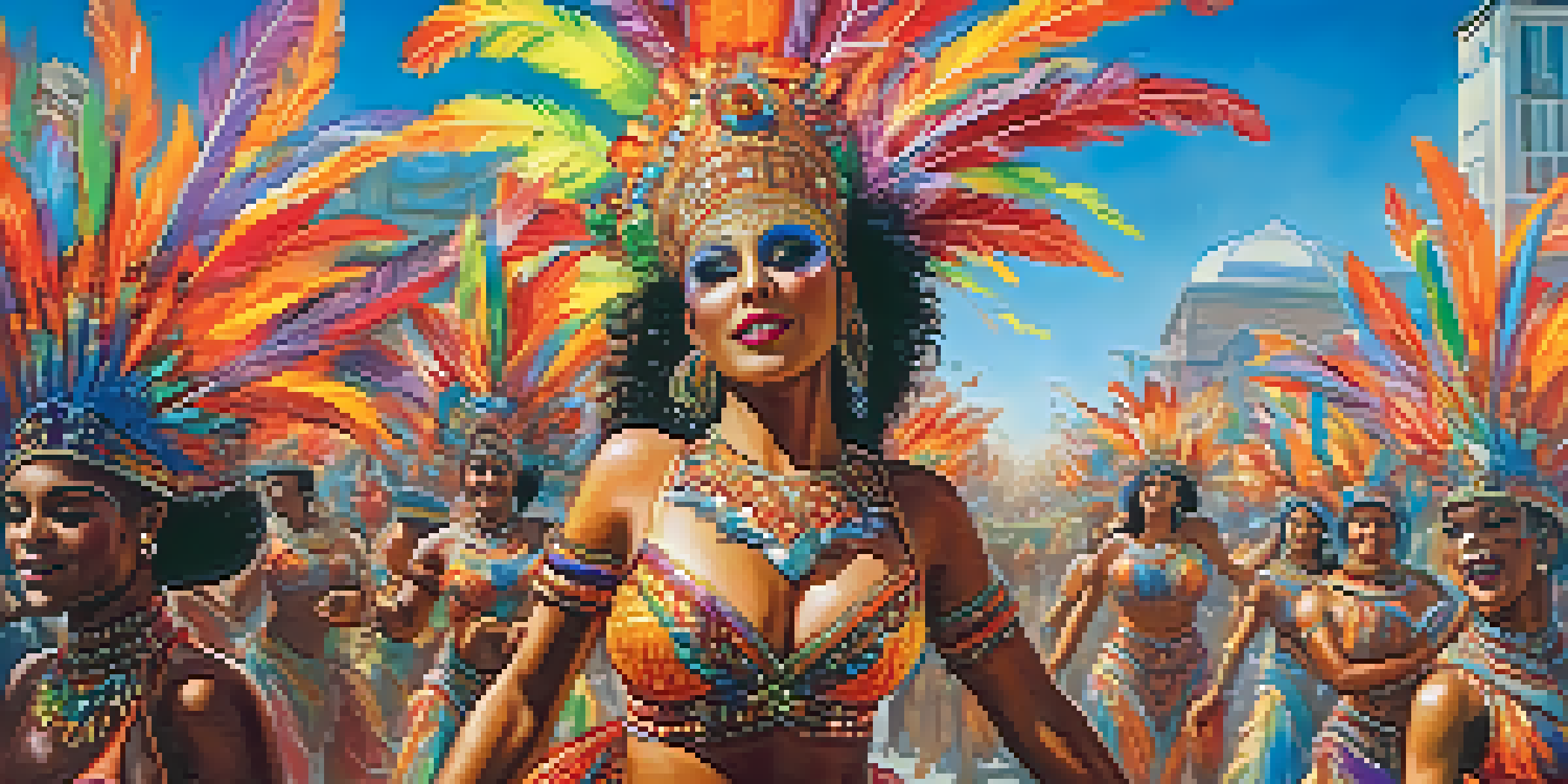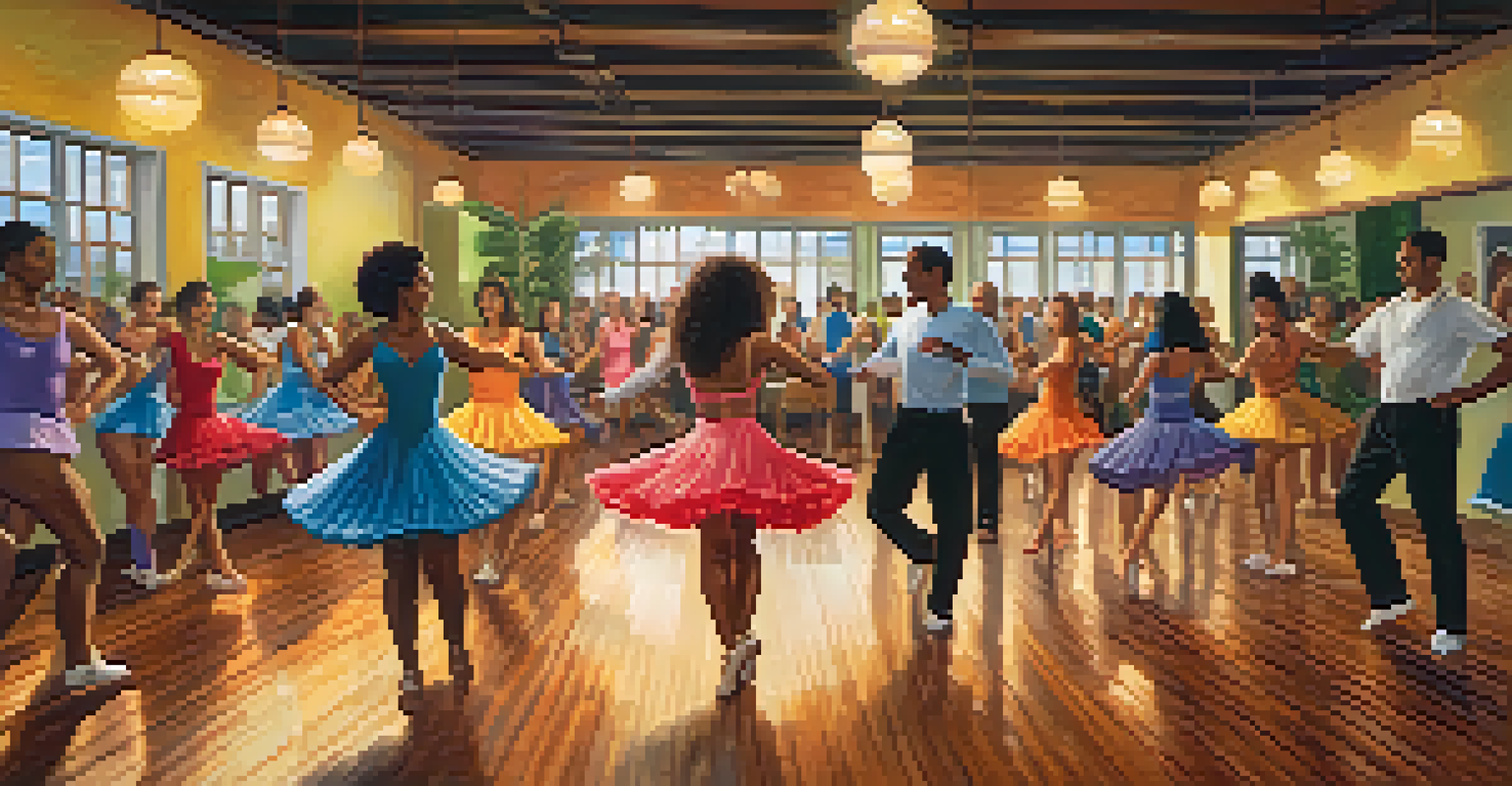Dance Your Way Through Brazil: Samba and Beyond

The Rhythmic Heart of Brazil: An Introduction to Samba
Samba is more than just a dance; it's a vibrant expression of Brazilian culture. Originating from Afro-Brazilian communities in the late 19th century, samba embodies the joy, resilience, and spirit of the Brazilian people. With its infectious rhythms and lively movements, samba invites everyone to join in the celebration of life.
Dance is the hidden language of the soul.
At its core, samba is deeply rooted in the history of Brazil, blending African influences with local traditions. During Carnival, samba takes center stage, captivating millions with its dazzling parades and energetic performances. The sound of drums and the sight of colorful costumes create an atmosphere that is both exhilarating and unforgettable.
But samba isn't just for the elite performers; it's a dance for everyone. In neighborhoods across Brazil, you'll find locals gathering to dance and celebrate, showcasing the communal spirit that samba fosters. Whether you're a seasoned dancer or a curious beginner, samba welcomes you with open arms.
Exploring Other Dance Styles: Beyond Samba
While samba is perhaps the most famous, Brazil boasts a rich tapestry of dance styles that reflect its diverse culture. For instance, forró, a lively partner dance from the northeast, combines influences from European folk dances and African rhythms. It's a wonderful way to connect with others and experience the warmth of Brazilian hospitality.

Another noteworthy style is bossa nova, which elegantly blends samba with jazz influences. This dance and music genre emerged in the 1950s and is known for its smooth, laid-back rhythms. It's perfect for those cozy evenings when you want to sway gently to enchanting melodies.
Samba: A Vibrant Cultural Expression
Samba is a lively dance that embodies the joy and spirit of Brazilian culture, inviting everyone to participate in its celebrations.
And let's not forget frevo, a fast-paced dance with roots in Pernambuco that incorporates acrobatics and colorful umbrellas. Frevo is all about energy and expression, making it a thrilling experience for both dancers and spectators. Each of these styles showcases the incredible diversity of Brazil's cultural landscape.
The Role of Dance in Brazilian Festivals
Festivals are a cornerstone of Brazilian culture, and dance is at the heart of these lively celebrations. The most famous, of course, is the Carnival, where samba schools compete with elaborate floats and breathtaking performances. This event draws millions of visitors worldwide, eager to experience the magic of samba firsthand.
Dancing is like dreaming with your feet!
Beyond Carnival, there are numerous regional festivals that celebrate different music and dance styles. For example, Festa Junina in June features traditional dances like quadrilha, where couples perform synchronized steps in a festive atmosphere. These local celebrations foster community spirit and keep cultural traditions alive.
Participating in these festivals offers a unique opportunity to immerse yourself in Brazilian culture. Whether you're dancing in the streets or watching a performance, the infectious energy of the crowd is sure to leave a lasting impression. Dance in Brazil truly brings people together, transcending language and background.
Dance as a Language: Connecting People Through Movement
Dance has a unique ability to break down barriers and connect people from all walks of life. In Brazil, dance serves as a universal language, allowing individuals to express themselves without words. When you step onto the dance floor, you're not just moving to the music; you're sharing a moment of joy and connection with others.
Consider a crowded street party, where people of different ages and backgrounds come together to dance. You'll see smiles, laughter, and spontaneous joy as everyone participates, regardless of their skill level. This sense of community is a fundamental aspect of Brazilian culture, where inclusivity is celebrated.
Dance Connects Communities
Dance in Brazil serves as a universal language, bringing people together and fostering a sense of community through movement.
Learning a dance like samba is not just about mastering steps; it’s about understanding the rhythm of life in Brazil. As you dance, you absorb the culture, the history, and the stories that have been passed down through generations. It's an experience that transcends mere entertainment and becomes a meaningful connection.
The Global Influence of Brazilian Dance
Brazilian dance has transcended borders, influencing artists and dancers worldwide. From the vibrant beats of samba to the smooth rhythms of bossa nova, these styles have found their way into dance studios and music scenes across the globe. This widespread appeal showcases the universal nature of dance as a form of expression.
In cities like New York and London, you can find samba classes and forró parties, allowing locals to experience a taste of Brazil. This cross-cultural exchange enriches the dance community, as people incorporate their own styles and interpretations. It’s a beautiful reminder of how art can unite diverse cultures.
Moreover, international collaborations often lead to innovative fusions, breathing new life into traditional dances. Whether through fusion dance competitions or global festivals, Brazilian dance continues to inspire and connect people worldwide, proving that dance knows no boundaries.
Getting Started: How to Dive into Brazilian Dance
If you're eager to join in on the fun, getting started with Brazilian dance is easier than you might think. Many cities offer classes for beginners, where you can learn the basics of samba, forró, or other styles in a friendly environment. These classes are not just about learning steps; they’re about meeting new people and having a good time.
Online tutorials and dance challenges are also great ways to practice at home. Platforms like YouTube have countless videos that break down steps and techniques, making it accessible for everyone. Plus, it's a fantastic way to incorporate some movement into your daily routine while having fun.
Global Influence of Brazilian Dance
Brazilian dance styles like samba and bossa nova have inspired artists worldwide, showcasing the universal appeal of dance as a form of expression.
Lastly, don't hesitate to attend local dance events or social gatherings. These settings provide a relaxed atmosphere to practice your skills and connect with fellow dance enthusiasts. Remember, the goal is to have fun and celebrate the joy of movement—so let loose and enjoy the rhythm!
Embracing the Joy of Dance: A Personal Journey
Embracing dance is not just about the movements; it’s about the joy and freedom it brings. Many people find that dancing helps them express emotions and relieve stress, creating a sense of happiness that can be hard to find elsewhere. This personal journey often leads to self-discovery and newfound confidence.
Consider the story of a shy individual who stepped into a dance class for the first time. Initially hesitant, they soon found themselves swept up in the rhythm, laughing and enjoying the experience. As they danced with others, they formed connections and friendships, highlighting how dance can transform lives.

In the end, dance is a celebration of life, culture, and community. Whether you're dancing in Brazil or your local studio, remember that every step is an opportunity to connect with yourself and others. So, take that leap and dance your way through life—it's a journey worth celebrating!